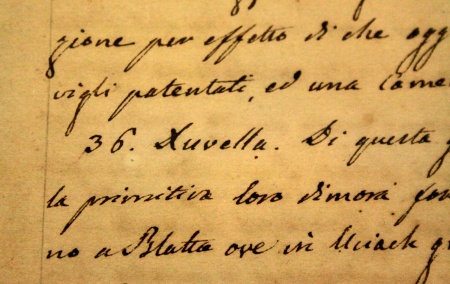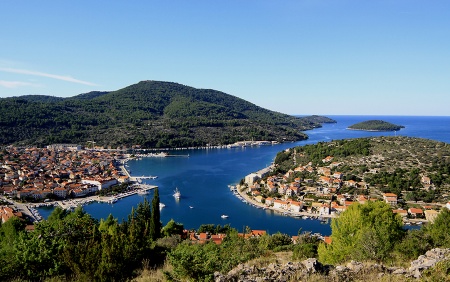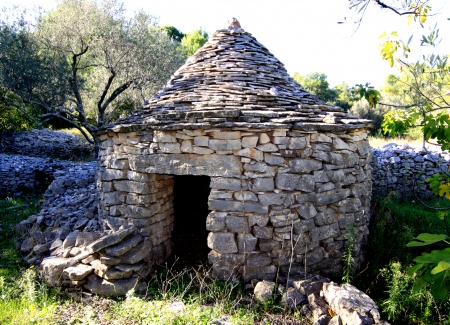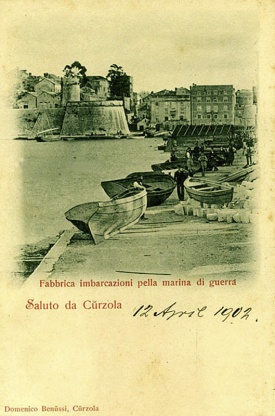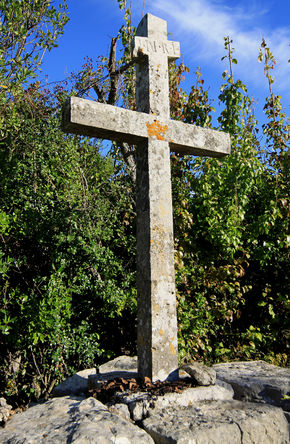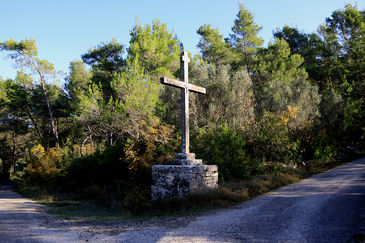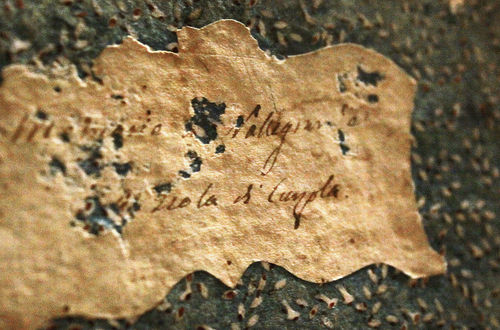Difference between revisions of "Directory:Zuvela"
m (→Are all Zuvelas descended from these individuals ?: sentance mv) |
|||
| Line 173: | Line 173: | ||
For many centuries Romance Latin language called Dalmatian and the old Croatian Chakavian language were the norm on the island. With time these languages started to overlap. By the time the Zuvelas arrived on the island the majority of the population of the island of Korčula (in particularly the west end) spoke ''old Croatian'' <ref>Closely related to Chakavian of the 15th century. " ''..... Chakavian dialects of western Croatia, Istria, the coast of Dalmatia (where a literature in that dialect developed in the 15th century), and some islands in the Adriatic. In those areas...'' " '''taken''' from http://www.britannica.com/EBchecked/topic/104539/Chakavian</ref> with a heavy mix of the Romance Dalmatian language,<ref>''"Dalmatian language, extinct Romance language formerly spoken along the Dalmatian coast from the island of Veglia (modern Krk) to Ragusa (modern Dubrovnik). Ragusan Dalmatian probably disappeared in the 17th century; the Vegliot Dalmatian dialect became extinct in the 19th century"'' '''taken''' from http://www.britannica.com/EBchecked/topic/150247/Dalmatian-language.</ref> and with influences of Venetian. This is in essence is the old Korčula dialect. | For many centuries Romance Latin language called Dalmatian and the old Croatian Chakavian language were the norm on the island. With time these languages started to overlap. By the time the Zuvelas arrived on the island the majority of the population of the island of Korčula (in particularly the west end) spoke ''old Croatian'' <ref>Closely related to Chakavian of the 15th century. " ''..... Chakavian dialects of western Croatia, Istria, the coast of Dalmatia (where a literature in that dialect developed in the 15th century), and some islands in the Adriatic. In those areas...'' " '''taken''' from http://www.britannica.com/EBchecked/topic/104539/Chakavian</ref> with a heavy mix of the Romance Dalmatian language,<ref>''"Dalmatian language, extinct Romance language formerly spoken along the Dalmatian coast from the island of Veglia (modern Krk) to Ragusa (modern Dubrovnik). Ragusan Dalmatian probably disappeared in the 17th century; the Vegliot Dalmatian dialect became extinct in the 19th century"'' '''taken''' from http://www.britannica.com/EBchecked/topic/150247/Dalmatian-language.</ref> and with influences of Venetian. This is in essence is the old Korčula dialect. | ||
| − | So with time verbally Antonio would become '''Antun''' or Ante. Written language was a different story, Latin and Venetian Italian were the standard written language back then so Antonio still existed in written form. | + | So with time verbally Antonio would become '''Antun''' or Ante. It is quite possible that both verbally Antonio and Ante were used at first with Antonio slowly disappearing from local language. Written language was a different story, Latin and Venetian Italian were the standard written language back then so Antonio still existed in written form. In 1797 the island of Korčula was no longer part of the Republic of Venice. The last Italian language government school was abolished in the town of Korčula on the 13th of September 1876. |
Currently my thoughts on the actual word Xuvella as a surname might have been created (''or'' reinterpret) with the Zuvelas arrival on the island in the early 1600s, which signalled a new fresh start for the family. | Currently my thoughts on the actual word Xuvella as a surname might have been created (''or'' reinterpret) with the Zuvelas arrival on the island in the early 1600s, which signalled a new fresh start for the family. | ||
Revision as of 02:58, 2 January 2017
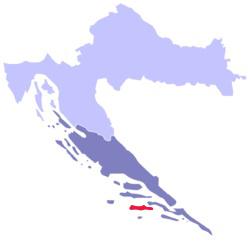
The Zuvela surname has strong roots originating from the western end of the island of Korcula in Croatia. Its original spelling was Xuvella. Another variation on the surname is Zuvella. In the Croatian language the Z in Zuvela is actually Ž. The ž is pronounced as J in French zh.
The Zuvela’s arrived on the west end of Korčula [1] in the early 1600’s and settled in a small field called Rasohatica (previously know as Rasohatija). There are still small remnants of stone huts there to this day. First time the surname Xuvella was mentioned was in Blato (previously know as Blatta) in a document dated 2nd of February 1642.[2] At the time, Korčula was part of the Republic of Venice within the Venetian Dalmatia province.[3] From where the original Xuvellas migrated is still a mystery to this editor. The Republic of Venice did accept refugees and migrants within her boundaries during her long history. They came from all parts of Europe. Many of them were from Spain [4][5] as well as Christians from the Ottoman Empire which ruled the Balkans for centuries.[6]
The Zuvelas abandoned Rasohatica and moved to the village of Blato. From there members of the Zuvela family moved to (and helped to establish) the town of Vela Luka (previously know as Vallegrande). In more modern times they have migrated to Australia as well as the United States and other parts of the world.
The information concerning the early Zuvelas of Korčula is taken from a local 19th century historian from Blato called Nikola Ostojic (below):
He wrote a book about the town of Vela Luka in 1853. The book was published in 1953. It was originally written in Italian with a Venetian dialect. Italian was the official language of the Dalmatian province[8] at the time and had been so for centuries.
In the 1860s the Croatian language which was sometimes referred to as Illirski in the 19th century [9] was introduced by the Austrian authorities as a second standardised language within the Kingdom of Dalmatia (which was part of the Austro-Hungarian Empire). It then slowly replaced Italian altogether.Thus the name Xuvella became Žuvela. From the late 19th century onwards the Dalmatian Italian culture has all but disappeared from the region. The last Italian language government school was abolished in Korčula (previously know as Curzola) on the 13th of September 1876.[10][11]
- Beginnings of Formal Education - Vela Luka states:
Historically the mother tongue of the majority of the population of the island of Korčula (in particularly the west end) is old Croatian.[13] The Korčula dialect [14] of local Croatian language acquired many influences over the centuries, such as the now extinct Latin Romance language Dalmatian,[15] Venetian and others.
Vela Luka Primary School - Osnovna Škola "Vela Luka" info & Mike Zuvella From USA
Below is information taken from the Vela Luka Primary School records. It mentions one Xuvella Giacobbo di Francesco:
- School year 1862./63.; III. r. (grade) Xuvella Giacobbo di Francesco [16]
Note according to www.familysearch.org a one Mike Zuvella was born on:
- 14th March 1884 in the city of San Francisco-California, USA passed away in October 1970. [17]
Images
New York Passenger Arrival Lists (Ellis Island), 1892-1924
In 1907 a young 18 year old Peter Zuvela arrived in New York. On the "List or Manifest of alien Passengers for the U.S Immigration Officer at port of arrival" his name is registered as Peter Ante Zuvela. Later for some reason it was change to Peter Zuvola. In the actual Immigration Manifest there is mention of another Zuvela, both were registered as Non Immigration Aliens.
Below info taken from familysearch.org.[18]
- Given name: Peter A...
- Surname: Zuvola
- Last place of residence: Vela Luka
- Date of arrival: 08 Mar 1907
- Age at arrival: 18y
- Ethnicity: Austrian, Dalmatian
- Port of departure: Trieste
- Port of arrival: New York
- Gender: Male
- Marital status: S
- US citizen:
- Ship of travel: Pannonia
New York Passenger Arrival Lists (Ellis Island)
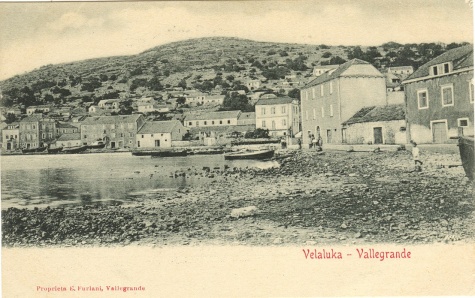
List from Korǒula [19]:
The spelling is per the New York Passenger Arrival Lists of Ellis Island.
1. Doda Marino Zuvela - Curzola 1901
2. Kokot Vinc. Zuvela - Corzola 1901
3. Iroce Nicolo Zuvela - Vallegrande 1902
4. Petrun Antonio Zuvela - Vallegrande 1902
5. Antonio Zuvela - Vollegrande 1903
6. Geovanni Zuvela - Triest 1903
7. Luigia Zuvela - Velaluha, Austria 1904
8. Doda Zuvela - Velaluha, Austria 1904
9. Vincenzo Zuvela - Vallegrande 1904
10. Piotr Zuvela-Kroz..., Austria 1905
11. Giorgis Zuvela - Cuyola 1906
12. Marin Zuvela - Veloluka 1906
13. Petar Zuvela - Veloluka 1906
14. Ivan Zuvela - Blatto, Dalmatia 1910
15. Tote Zuvela - Blato, Austria 1910
16. Marko Zuvela - Blatto, Dalmatia 1910
17. Jerko Zuvela - Velaluka 1912
18. Yela Zuvela - Vallegrande, Austria 1914
19. Petar Zuvela - Raguse, Herzegov (USA) 1920
20. Mare Zuvela Grizim - Valegranda, Jugoslavia 1921 [20]
Additional surnames similar to Zuvella but not of Korčula origins:
- Felippa Zavello Ianain 1892
- Angela Zavello Oddalengo, Oddalengo, Grande, Italy 1907
- Emanuele Zivello Castelfranci, Italy 1910 [1]
- Athena Zouvella from Zakynthos, Greece 1922 [2]
- Franceso Zavello 1922
Gallery-Zuvela Crosses & FX signature on the Island of Korcula
THE OLD XUVELLAs
Based on the records which are available to me, I have come to this conclusion written below. My research is largely based on the writings of Zvonko Maricich (Maričić) and Nikola Ostojic plus three Family Trees of the Zuvelas that were kindly given to me.
CONCLUSION
The Xuvellas came to the island of Korčula in the 1630s, then part of the Republic of Venice. Most likely refugees, they settled in the west end of Korčula (back then referred to as Curzola). They set up residency in a small field called Rasohatica (then called Rasohatija).
Three male names come up in my research that are not recorded as being born on Korčula (not registered via church records of births).
One being Antonio Xuvella who is not part of the Žuvela family trees but is mentioned in town documents. The oldest being dated 2nd of February 1642. [21] Then we have Matteo Xuvella [22] and finaly Cosma Xuvella. [23]
The Newly Arrived Xuvella's Had Two Sons
With the current records that are available I can confirm the newly arrived Xuvella's had two sons who were named Antonio Xuvella (b.1651)[24] and Giovanni Xuvella which I have written here in old Venetian Italian.
Antonio married FRANCISCA (Croatian: Frana) and they had two sons. The two sons were named:
- Matteo born 1670 (Matija in Croatian)
- Marino born 1675 (Marin in Croatian).
Additional: According to the Zuvela-Grizun family tree there are three more siblings:
- Giovanni born 1681 (Ivan in Croatian)
- Jacquilin born 1683 (Jaka in Croatian)
- Nicolo born 1684. (Nikola in Croatian)
Cosma Xuvella had a son called:
- Giovanni, year mentioned 1672 [25] (Ivan in Croatian)
Are all Zuvelas descended from these individuals ?
One has to ask, is it possible that the Zuvela families are all descended from the individuals mentioned above? It’s most likely true. We may also be looking at the original residents of Rasohatica!
The early Zuvelas were no time wasters. A Mr Antonio Xuvella in the 1640s was an owner of no less than 211 sheep. The Xuvellas moved to the near by village of Blato (then called Blatta) and bought houses and properties there.
For many centuries Romance Latin language called Dalmatian and the old Croatian Chakavian language were the norm on the island. With time these languages started to overlap. By the time the Zuvelas arrived on the island the majority of the population of the island of Korčula (in particularly the west end) spoke old Croatian [26] with a heavy mix of the Romance Dalmatian language,[27] and with influences of Venetian. This is in essence is the old Korčula dialect.
So with time verbally Antonio would become Antun or Ante. It is quite possible that both verbally Antonio and Ante were used at first with Antonio slowly disappearing from local language. Written language was a different story, Latin and Venetian Italian were the standard written language back then so Antonio still existed in written form. In 1797 the island of Korčula was no longer part of the Republic of Venice. The last Italian language government school was abolished in the town of Korčula on the 13th of September 1876.
Currently my thoughts on the actual word Xuvella as a surname might have been created (or reinterpret) with the Zuvelas arrival on the island in the early 1600s, which signalled a new fresh start for the family.
See also
- Korcula Dialect
- Korcula History, Romans & Venice
- Croatian Slavic Identity
- Vallegrande Speak
- Siloko Restaurant on the island of Korcula
Notes and References
- ^ In Croatian the c in Korcula is pronounced ch and is written "č".
- ^ Vela Luka od 1490 do 1834 by Zvonko Maričić (p168)
- ^ John Everett-Healu. "Dalmatia." Concise Dictionary of World Place-Names. Oxford University Press. 2005. Encyclopedia.com
- ^ Dalmatia and Montenegro: With a Journey to Mostar in Herzegovina -Volume 1 by John Gardner Wilkinson (p116).
- ^ There is a theory that the Xuvellas were Spanish-Jews who were expelled in 1493 from Spain. From there they moved to Italy and then to the Republic of Venice. Referenced from www.webanswers.com. Jew in old Venetian is abreo, xudio and sabadai. Xuàne in Venetian is John and Jovàni (j is spoken as in French Jardin). The Latin Iudaeus means Judaean, "from the land of Judaea". The closet city within the Republic with a Jewish population was Splato (modern Split). If this theory is correct it could be the Xuvellas were Conversos Jews or New Christians.
- ^ The Land of 1000 Islands by Igor Rudan Copyright © 2006 by the Croatian Medical Journal. All rights reserved.
- "However, the clashes between the Ottoman Empire and Venetian Republic produced extensive migrations from the mainland areas, especially from today's Bosnia and Herzegovina, to the eastern parts of the islands of Brac, Hvar, Korcula, and Pag."
- ^ Vela Luka-Historijsko Topografski Prikaz by Nikola Ostojić
- ^ Osnovna Škola "Vela Luka" Vela Luka Zbornik-150 Godina Školstva u Velaoj Luci (p12)
- ^ Illyricum was a province of the Roman Empire. It was named after one of the indigenous peoples in that region.
- ^ The Italians of Dalmatia by Luciano Monzali (p83)
- ^ Editor's Note: In the neighbouring Kingdom of Croatia-Slavonia (within Austro-Hungarian Empire) a Croatian nationalistic movement was established and alongside that, within the Balkan region a Pan-Slavic movement was growing (the beginnings of the ill fated Yugoslavia). These political on goings started to be felt in the Kingdom of Dalmatia. The Austrians in the 1860s started to introduce (a process of Croatisation) within the Kingdom of Dalmatia a standardised Croatian language sometimes referred to as Illirski. It then replaced Italian altogether. In effect the government undertook culture genocide. For centuries the Italian language was the official language of the Dalmatian establishment. It was also the spoken language in white-collar, civil service and merchant families. For a few years Italian schools were still being run privately in the Kingdom of Dalmatia, i.e the city of Zadar and Split (Lega Nazionale at Spalato).
- ^ The Early Beginnings of Formal Education - Vela Luka (beginnings of literacy and Lower Primary School 1857 – 1870) (p.12 written in Croatian, Vela Luka Zbornik-150 Godina Školstva u Velaoj Luci)
- ^ Editors note: Recent DNA studies have stated that more than three quarters of today's Croatian men are the descendants of Europeans who inhabited Europe 13 000-20 000 years ago. The term Slav was first used by the Byzantines (i.e. Procopius-Byzantine scholar, Jordanes- 6th century Roman bureaucrat) and was recorded in the 6th century (cia. 550) in Greek (Σκλαβῖνοι-Sklabenoi). Later in Latin it was written Sclaveni. Slavic tribes invaded the region of Roman Dalmatia in the early Middle Ages. Prior to the arrival of the Slavs, Roman Dalmatia was mainly inhabited by a Roman Latin-Illyrian population. The first primary source (factual-that its authenticity isn't disputed) to mention the Croatian-Hrvat identity in the Balkans was Duke Branimir (Latin: "Branimiro comite dux cruatorum cogitavit" c. 880 AD). Branimir was a Slav from Dalmatia.
- ^ NOTE: The local dialect is sometimes referred to as Naski or more correctly Naški. The š is pronounced sh.
- Sir John Gardner Wilkinson (an 19 century English historian. October 5, 1797 – October 29, 1875) was an English traveller, writer and pioneer Egyptologist of the 19th century. He is often referred to as "the Father of British Egyptology". He referred to the Dalmatian Slavic (old Croatian) as Illirskee. Cited from Dalmatia and Montenegro: With a Journey to Mostar in Herzegovina by Sir John Gardner Wilkinson. (p33)
- ^ Collegium Antropologicum, Volumes 15-16 by Croatian Anthropological Society-1991. (p311)
- ^ Osnovna Škola "Vela Luka" Vela Luka Zbornik-150 Godina Školstva u Velaoj Luci (p50)
- The Early Beginnings of Formal Education - Vela Luka (beginnings of literacy and Lower Primary School 1857 – 1870):
- ^ www.familysearch.org: Mike Zuvella
- ^ www.familysearch.org: Peter A... Zuvola
- ^ mainly referenced from https://familysearch.org/search/collection/results?count=20&query=%2Bsurname%3AZuvela~&collection_id=1368704
- ^ referenced from https://familysearch.org/ark:/61903/1:1:J6NH-PTP
- ^ Vela Luka od 1490 do 1834 by Zvonko Maričić (p168). It mentions Antun (Antonio) who is not part of the Žuvela Korčula born family trees (or any family tree). This could indicate him as a Korčula island migrant arrival.
- ^ according to one of the Žuvela family tree Antonio was born 1651 and is the son of Matteo. Matteo Xuvella is not part of the Žuvela Korčula family trees as being born on the island, this may indicate him as a migrant arrival.
- ^ Info obtain via Zvonko Maricich's work. He writes "…. or Ivan Zuvela son of the late Kuzme 22nd of December 1672". Ivan in Venetian Italian is Giovanni and Kuzme in Venetian Italian is Cosma. Kuzme was a witness to a contract being signed. Refernced from Vela Luka od 1490 do 1834 by Zvonko Maričić, page 168. Cosma Xuvella is not part of the Žuvela Korčula family trees as being born on the island, this may indicate him as a migrant arrival.
- ^ Matteo was given to him as as a middle name
- ^ Vela Luka od 1490 do 1834 by Zvonko Maričić (p168)
- ^ Closely related to Chakavian of the 15th century. " ..... Chakavian dialects of western Croatia, Istria, the coast of Dalmatia (where a literature in that dialect developed in the 15th century), and some islands in the Adriatic. In those areas... " taken from http://www.britannica.com/EBchecked/topic/104539/Chakavian
- ^ "Dalmatian language, extinct Romance language formerly spoken along the Dalmatian coast from the island of Veglia (modern Krk) to Ragusa (modern Dubrovnik). Ragusan Dalmatian probably disappeared in the 17th century; the Vegliot Dalmatian dialect became extinct in the 19th century" taken from http://www.britannica.com/EBchecked/topic/150247/Dalmatian-language.
External links
- Photo link for a aerial view of Korcula Town
- Trullo
- Natasha Zuvela - Australian TV Presenter, Speaker and Author
- Tony Zuvela - Australian cartoonist
- Paul Zuvella - former USA Major League Baseball player
- Korcula Info

Croatia Dubrovnik Neretva County Korčula Dalmatia Dalmatian Language Korcula History Korčula Vela Luka Blato Dalmatian Republic of Venice Venetian Natasha Zuvela Tony Zuvela Paul Zuvella

